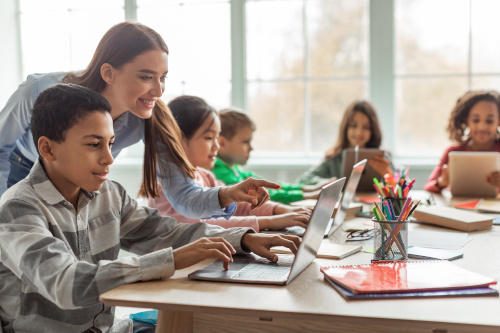When I started as a school counselor more than 15 years ago, technology in the classroom looked much different than it does today. Only a handful of students had their own personal device and the concept of one-to-one models, meaning every student is given a school-issued laptop or tablet, had not yet taken hold. At that time, students were accessing the internet or using digital tools sparingly throughout the school day, and typically only in tech-focused classes. Today, most teens have access to a smartphone and more than 80 percent of K-12 students use a school-issued device as part of their learning. Students are clearly more connected than ever, both inside and outside of the classroom.
This increased access to technology in school has had both positive and negative impacts on students. For some, the internet has proven to be an incredibly engaging and useful learning tool, while for others, the constant stream of information can be overwhelming. Because of this, it is important for educators to help students use technology in a purposeful way that supports learning.
While it might seem counterintuitive, technology and certain digital tools can actually help provide students with a sense of calm while enhancing in-the-moment thinking.
Here are five ways I have seen technology serve as a remedy for brain overload:
1. Mental health check-ins to start class
The short time between class periods is often hectic, with many students physically moving to different classrooms or mentally preparing to dive into a new subject. Hallway passing time can also be filled with stressful social interactions or glances at social media.
Well-being check-ins at the beginning of class can be a great way to help students regain focus and center their thoughts. Simple online tools that let you survey your class – like Pear Deck, Google Forms, or Kahoot – can be used to support these emotional checks. Asking questions along the lines of “How are you feeling today?” or “What color would best describe your mood today and why?” and allowing students to respond anonymously can be a game changer in the classroom.
2. Mindfulness apps
Helping students practice mindfulness, or the ability to be present in the moment and aware of thoughts, feelings, and sensations, can greatly benefit mental health far beyond the classroom. In addition to non-tech strategies like paper mood boards, mindfulness dice, or breathing exercises, there are free digital tools and apps like Calm, Headspace, and more that can guide students through mindfulness exercises in both a group or individual setting.
Related:
How to identify student anxiety in the classroom
Teachers can’t keep up with the need for SEL
3. Private, digital feedback
Some students are not comfortable raising their hands in class or asking for feedback in a group setting. Leveraging solutions that have chat features or allow for real-time digital feedback on student work is a great way to engage students who prefer more private communication.
There are also certain classroom discussions where anonymity is key. If there is a conversation of a sensitive nature, where not even the teacher needs to know whose answer is whose, anonymous feedback will help educators facilitate an honest, open discourse. This way, students will feel more comfortable sharing their responses knowing that they are anonymous. Try utilizing digital tools that support this kind of safe engagement.
4. Audio & visual tools
Classroom environments can directly impact students’ ability to learn. Adding calming music, videos, or lighting can help put students at ease and create a more peaceful learning space. Music has shown to help improve focus, and there are endless playlists with classroom-appropriate songs available through services like Spotify or YouTube. Projecting videos of a fireplace, waves on a beach, or slow-moving clouds to the front of the classroom during work time can also help create a more relaxing atmosphere.
5. Digital guardrails
When students are using their school-issued devices, it can be helpful to set thoughtful guardrails or parameters around which web pages they can or cannot access during class. Certain filtering solutions or classroom management products can help narrow or broaden internet access depending on what is needed for the day’s lesson. This helps students focus on the task at hand and reduces information overload or distractions.
For today’s students who often find themselves overloaded, a calming learning environment can serve as a much-needed moment of stillness. As classroom technology continues to evolve, educators and school mental health professionals can use strategies like the above to help students navigate their digital world with purpose.
- 3 ways to avoid summer learning loss - April 19, 2024
- High school students say AI will change the workforce - April 18, 2024
- Motivating students using the Self-Determination Theory - April 17, 2024


